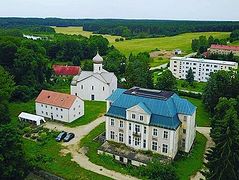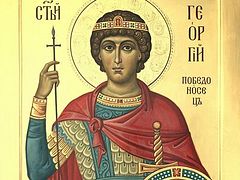What titles does the Orthodox Church not use to exalt Saint George the Great-Martyr? He is called “the greatest among the great martyrs,” “chief of the ranks of martyrs,” “renowned for miracles everywhere,” “swift to help,” and more. These lofty names bear witness to the countless miracles that have occurred—and continue to occur—throughout the Christian world through the intercession of Saint George before God.
Below is a small collection of such miracles that took place in the relatively recent past in various parts of the world.
The Novice
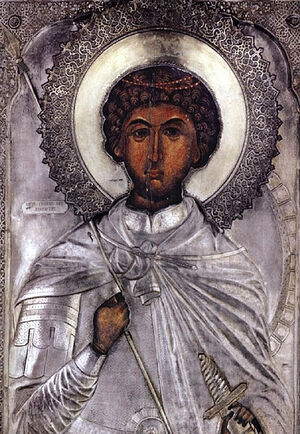 Icon of St. George “The Appeared” If Mount Athos is considered the Garden (or lot) of the Most Holy Theotokos, then Saint George is often referred to as the guardian of that garden.
Icon of St. George “The Appeared” If Mount Athos is considered the Garden (or lot) of the Most Holy Theotokos, then Saint George is often referred to as the guardian of that garden.
Two major monasteries—Zographou and Xenophontos—have their catholicons (main churches) dedicated to him. Additionally, many chapels, cells, and small monastic structures—kathismas and kelia—named in honor of the Great-Martyr George are scattered all over the Holy Mountain.
One such kellia, rumored to be quite wealthy and inhabited by two elderly monks, was under the jurisdiction of Pantokrator Monastery.
One night, strangers knocked on the door of the cell. A voice from within asked who they were and why they were knocking at such a late hour. The visitors replied that they were pilgrims in need of shelter for the night.
A young novice opened the door for them. Three men stood before him and asked to see the elder monks. The novice led them into the archondarikon (guest reception room) and asked them to wait.
The strangers sat and waited. The cell was completely silent. Two hours passed in heavy anticipation. Finally, the visitors tried to stand up—but found they couldn’t move: invisible bonds held them tightly, binding their hands and feet.
Cries of distress rang out in the cell. The two elderly monks, awakened in alarm, ran to the archondarikon, where they found the strangers crying out wildly in terror.
“Who are you? What do you want? How did you get in here?” the monks asked in confusion.
“Your young novice let us in!”
“Novice? We have no novice living here!”
Then the “pilgrims” were forced to reveal the truth:
It turned out that one of them was the infamous bandit Stamatis, known for terrorizing the entire Chalkidiki Peninsula and even Mount Athos.
Together with two accomplices, Stamatis had targeted this particular kellia, knowing that it was inhabited by only two helpless elderly monks. Disguising themselves as pilgrims, they planned to gain entry, murder the monks, and rob the cell.
Everything would have gone according to plan—if not for that novice! But who was he? How did he end up at the kellia?
The monks realized that they had just witnessed a miracle. They hurried to the church and brought the icon of Saint George to the robbers.
When the bandits saw the image, they were horrified— it was the very “novice” who had let them in!
Yes, it was he who had opened the door!
And as they attempted to fall down before the icon, the invisible bonds were suddenly loosed.
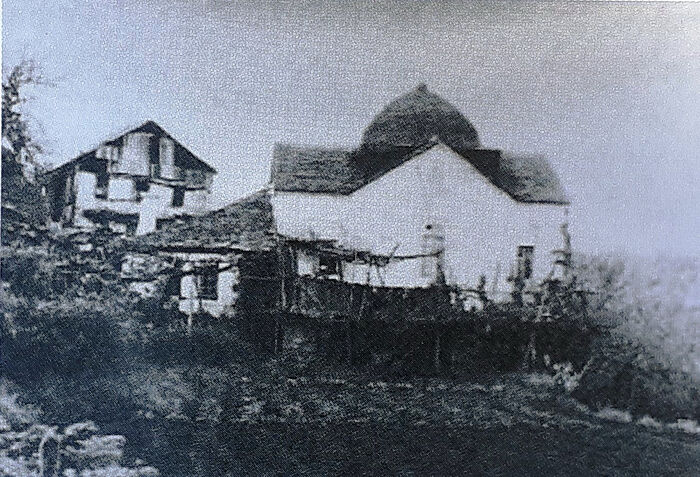 The Kellia of St. George the Appeared
The Kellia of St. George the Appeared
From that time on, the cell became known as the Kellia of St. George “the Appeared” (Faneromenos), and the icon is now kept in the catholicon of Pantokrator Monastery.
The miracle made such a profound impression on Stamatis that he abandoned his life of crime. He became the first to settle in the most desolate region of Mount Athos—Karoulia, where he built a hut with a small chapel dedicated to St. George. He eventually reposed in the Lord with the death of a righteous monk.
Protector of the Plant World
In Western Armenia (now within modern-day Turkey), in the region of Akn, the village of Vank was a well-known center for the veneration of St. George. The residents—predominantly Orthodox Armenians—had long considered St. George the patron of their village.
The old church of the village, dedicated to the Holy Great-Martyr, stood in a forest on the banks of the biblical Euphrates River.
This grove, being church property, was regarded as a sacred domain of St. George, and anyone who dared encroach upon it faced severe divine punishment.
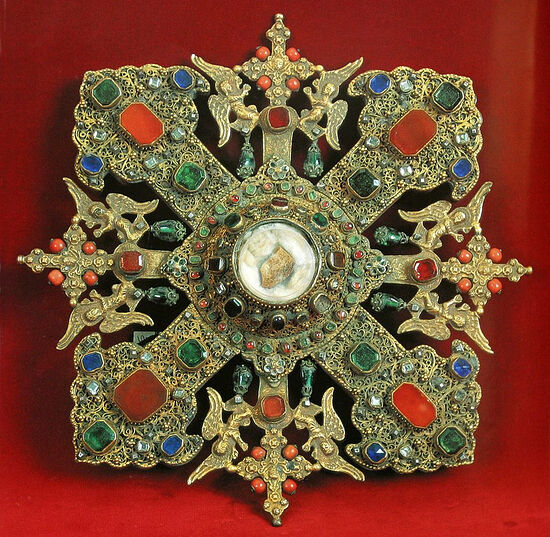 Reliquary Cross with a particle of St. George’s skull (Treasury of the Mother See of Holy Etchmiadzin, Armenia)
Reliquary Cross with a particle of St. George’s skull (Treasury of the Mother See of Holy Etchmiadzin, Armenia)
Once, a Turk, disregarding the “infidel” sanctuary, went into the forest to gather firewood. He chopped down a living tree, hoisted the wood onto his shoulders, and pleased with his work, began heading home—when suddenly, he saw before him a horseman riding a gray steed, dressed in a scarlet cloak.
The rider drew his sword, raised it high above the head of the profane trespasser, and sternly warned: “If you ever return to this forest to cut trees again, I will strike you down! If you must, you may cut the dead wood—but do not dare lay a hand on the living trees!”
After this, the Turk fled in terror to the village, telling the Christians of the miracle and urging everyone to stay away from the forest. However, not everyone believed him.
One day, a Turkish woman entered the same sacred grove and cut down a partially dried tree. When the tree fell, she approached it to move it, but the moment she touched the trunk, she became completely paralyzed.
Standing before her was the very one who had bound her with invisible chains—St. George on horseback. The woman remained frozen the entire day, crying out for help.
Late that evening, her young son, frightened by her long absence, went into the forest to search for her and found her in a pitiful state. Through her sobs, she told her son what had happened and promised out loud never to enter the Christians sacred forest again.
The moment she made this vow aloud, the invisible chains fell, and she was able to stand upright.
The Mysterious Horseman
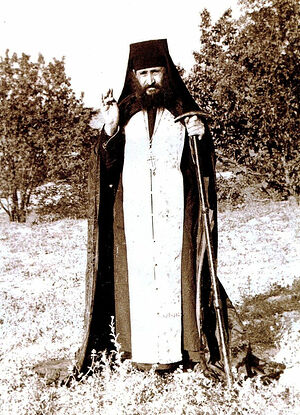 St. George (Karslidis) the Confessor On Byzantine icons, St. George is often depicted riding a horse, sometimes with a young boy seated behind him—a reference to a miracle in which St. George rescued a child from captivity and returned him safely home. For this reason, the Church calls St. George the Deliverer of Captives.
St. George (Karslidis) the Confessor On Byzantine icons, St. George is often depicted riding a horse, sometimes with a young boy seated behind him—a reference to a miracle in which St. George rescued a child from captivity and returned him safely home. For this reason, the Church calls St. George the Deliverer of Captives.
But miracles of St. George transporting people from one place to another are known even in our time. A vivid example is the miracle experienced by St. George the Confessor (Karslidis) (1901–1959), one of the remarkable ascetics of the twentieth century.
Born Athanasius Karslidis in the Pontic city of Argyroupoli, he lost his parents at an early age and was raised by his pious grandmother Anna. After her death, the seven-year-old moved with his grandfather to Erzurum (ancient Karin).
When his grandfather also reposed, Athanasius set out for the Caucasus alone, crossing snow-covered mountain paths, suffering from hunger and cold. Once, he was even buried under snow and was barely saved by a passersby.
On the brink of despair, Athanasius continued to pray with tears, asking for God s help. One day, along his journey, he was met by a mysterious horseman, who lifted the boy onto his horse and lovingly explained where he would take him and what he should do next.
Despite the great distance, the rider brought Athanasius to an unfamiliar city—it was the magnificent Tiflis (Tbilisi), the capital of the Caucasus. Athanasius followed the guidance he was given, and his path eventually led him to the New Athos Monastery.
Later in life, when he was ordained to the priesthood, Athanasius took the name George, in honor of St. George the Victory-Bearer—the very Horseman who had rescued him and set him on the path of God.
St. George Arrives Late to the Liturgy
Around the year 1903, a devout Orthodox Arab named Khalil Abufarha, the caretaker of a cave church in the Syrian village of Beit Sahour, went early in the morning to light the vigil lamps and prepare the church for Matins.
As he approached the church, he heard unfamiliar voices. To his astonishment, it seemed that a service was already underway.
Entering the cave, Khalil was stunned to witness a Divine Liturgy being celebrated—by angelic hosts and by the Most Holy Theotokos Herself!
He stood frozen, overwhelmed and immobile.
Suddenly, the sound of galloping hooves came from outside, and a young warrior entered the cave.
Without delay, he approached the Lady Theotokos with urgency.
“Where have you been, Saint George?” the Mother of God asked loudly. “Why did you arrive late?”
“O Lady Theotokos, I was at sea,” replied Saint George, “A boat was sinking in the open waters, and I rushed to save the people who were calling on me for help.”
As he said this, Saint George removed his wet cloak, and droplets from it splashed onto Khalil s face and clothes.
At the end of the Divine Liturgy, Khalil was granted the blessing of receiving the antidoron from the very hands of the Most Holy Virgin.
After that, the Theotokos, St. George, and the angels serving the Liturgy vanished.
A short while later, when the village priest and parishioners arrived at the church, they found Khalil still damp from St. George s cloak, gently cradling the antidoron he had received from the Blessed Virgin Mary.
Deliverance from Execution
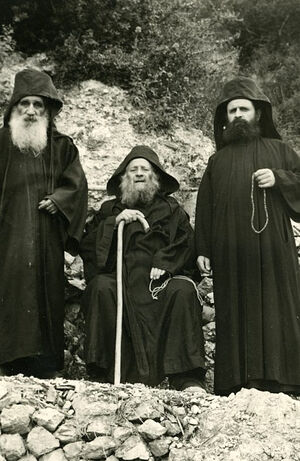 Fr. Charalambos (Galanopoulos)—pictured left of St. Joseph the Hesychast One of the disciples and close companions of the recently glorified Elder Joseph the Hesychast (1897–1959) was Fr. Charalambos (Galanopoulos, 1910–2001), abbot of the Mount Athos monastery of St. Dionysios. Born in Russia to a Pontic Greek family, Charalambos moved with his family at age ten to northern Greece, settling in the village of Arkadiko near Drama. Though he excelled in school, he left his studies to support his family.
Fr. Charalambos (Galanopoulos)—pictured left of St. Joseph the Hesychast One of the disciples and close companions of the recently glorified Elder Joseph the Hesychast (1897–1959) was Fr. Charalambos (Galanopoulos, 1910–2001), abbot of the Mount Athos monastery of St. Dionysios. Born in Russia to a Pontic Greek family, Charalambos moved with his family at age ten to northern Greece, settling in the village of Arkadiko near Drama. Though he excelled in school, he left his studies to support his family.
In 1941, during the Nazi occupation of Greece, the Bulgarian authorities arrested Charalambos along with fellow villagers and threw them into a concentration camp.
One week later, the unthinkable happened—the prisoners were sentenced to death. Charalambos fell to his knees weeping, and prayed fervently, “Holy Great-Martyr George, mighty warrior of Christ, save us— and I vow to dedicate my entire life to God!”
“As soon as I finished my prayer,” the elder later recalled, “I heard a tremendous noise above us—a galloping horse. I looked up, and there in the air, a horse was riding overhead, but I could not see the rider. Yet everything was clear to me! I said: This must be St. George—I’m simply unworthy to see him. Even just seeing the horse means he heard me!”
Early the next morning, the executioners entered the cell, ready to carry out the death sentence. But suddenly, the doors flew open, and a young man of powerful build stormed in, shouting, “Stop immediately, you criminals! Release these innocent people to their homes! Or I will shoot every one of you!”
The executioners, seized by terror, fled from the cell at once—and with them, the young man vanished. No one doubted it—this was none other than the Great-Martyr George himself. Shortly afterwards, a general amnesty was granted to the prisoners—in honor of the birth of the heir to the Bulgarian throne.
Nine years later, following this unmistakable miracle, Charalambos Galanopoulos left the world and came to Mount Athos, where he became a monk—fulfilling his vow to God and to St. George.
The Church Reopens
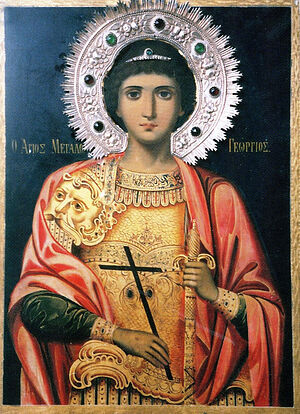 Icon of St. George from the Xenophontos Monastery on Mount Athos During the Khrushchev era, in the city of Samarkand, the Church of St. George the Victory-Bearer was served by Archimandrite Seraphim (Sutorikhin) (1901–1979), a man exiled and imprisoned for ten years under the Soviet regime.
Icon of St. George from the Xenophontos Monastery on Mount Athos During the Khrushchev era, in the city of Samarkand, the Church of St. George the Victory-Bearer was served by Archimandrite Seraphim (Sutorikhin) (1901–1979), a man exiled and imprisoned for ten years under the Soviet regime.
Old and frail, Fr. Seraphim became a spiritual beacon for many believers, especially the young. This influence angered the authorities.
With help from KGB informants, the Church of St. George was shut down, and Fr. Seraphim was forced to celebrate liturgies secretly, under the cover of night.
Two years passed. Eventually, officials decided to convert the church into a kindergarten. But one day, two horsemen entered the church courtyard—wearing strange, antique military uniforms.
The chief rider dismounted, entered Fr. Seraphim s cell (where the priest was praying), and gave a clear command: “Fr. Seraphim, prepare for the service: today the church will be reopened!”
The two officers then rode straight to the city executive committee. The commanding officer, without speaking to police or secretaries, stormed into the office of the committee chairman unannounced.
“The Church of the Great-Martyr George is to be reopened today—or you will be punished without mercy!” he declared sternly. The officer left as abruptly as he had come.
The chairman, shaken and terrified by something he could not explain, immediately phoned the state commissioner for religious affairs and pleaded, “Send someone at once to the Church of St. George the Great-Martyr—it must be opened immediately!”
And so, the church was indeed reopened that very day— the eve of May 6, the feast day of its patron saint. Later that day, the executive chairman arrived by car at Fr. Seraphim s home, eager to learn who this commanding church superior was. Fr. Seraphim showed him a photograph of the bishop of Tashkent.
“No, not him,” the chairman replied. “Do you have someone higher? Your superior came to see me yesterday—a military officer, oh... Such authority! He gave a direct order that the church be reopened immediately. Or else you will be punished without mercy, he said. You could tell right away that he was the boss!”
At that moment, Fr. Seraphim, with tears in his eyes, brought out an icon of St. George. Upon seeing it, the chairman—like the Athonite bandits of old—was seized with terror:
“Him!!! It was Him who came to me yesterday!”


